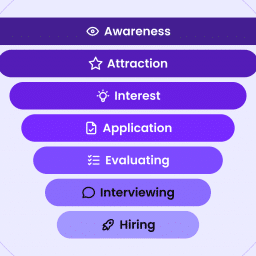

When it comes to recruiting, we all know that passive candidates—those who aren’t actively job hunting—can sometimes be the best talent out there. But engaging them? That’s where things get tricky.
These individuals aren’t scrolling job boards looking for job posts or keeping an eye on your career site like active candidates. Instead, they’re on social media engaging with content they find valuable, entertaining, or insightful. So, how do you capture their attention in a way that feels organic but still keeps your employer brand in the spotlight?
Let’s dive into five creative strategies to help you connect with passive prospects, build relationships, and position your company as the place they’ll want to work when they’re ready for a new challenge.
1. Create “day in the life” content to showcase roles
There’s something compelling about showing the real, day-to-day experience of working at your company. “Day in the life” content offers passive jobseekers a genuine, behind-the-scenes look at what it’s like to be part of your team. It’s authentic, human, and much more engaging than a dry list of job responsibilities.
Start by sharing short videos, Instagram Stories, or LinkedIn posts featuring different employees from various departments. Whether it’s a sneak peek into a project meeting or a glimpse of your office culture, this type of content helps potential applicants visualize themselves in the role. It’s not about selling a job—they’re not actively looking yet—but about planting that seed. You’re showing them that when they’re ready, your company is a place where they could see themselves thriving.
Plus, by featuring real employees, you’re making your employer brand more relatable. Passive jobseekers will see that the people at your company are just like them, and that makes a difference when they start thinking about career change.
2. Share insights that speak to what passive jobseekers want
Unfortunately, passive candidates likely aren’t looking for a job post to pop up on their feed. What they are looking for is valuable, relatable content that helps them in their career, keeps them informed, or aligns with their interests.
Instead of thought leadership content that feels more like marketing, focus on insights that connect to what they actually want from an employer.
Are employees in your industry talking about work-life balance, growth opportunities, or remote work flexibility? Share industry insights that show you understand these trends. Articles, reports, or even infographics related to these topics will resonate with passive jobseekers without feeling like a recruitment pitch.
Posting this type of content consistently builds trust. Passive jobseekers will start associating your brand with the values and opportunities they care about. And when they’re ready to explore new roles, they’ll remember you.
3. Leverage employee testimonials to humanize your brand
Who better to talk about your company than your employees? Sharing employee testimonials, whether in video or written format, gives your audience an authentic glimpse into your company culture.
When potential future applicants hear real people sharing their experiences—what they love about their jobs, how they’ve grown, or why they enjoy coming to work—it creates a level of emotional connection that no job description can achieve. As a bonus, reading a great testimonial might help passive candidates realize they aren’t actually satisfied in their current roles.
You can share these testimonials as LinkedIn posts, Instagram Stories, or even long-form articles. Remember to feature voices from across different departments and career levels, and pay extra attention to the career journeys of your employees. Passive jobseekers may not be in a rush to make a move now, but when they see that your company is a place where people grow, they’ll keep you in mind for later.
4. Offer career development tips to build long-term engagement
One of the best ways to engage passive jobseekers is by offering them something of value. Sharing career development tips, like how to improve leadership skills or navigate a career pivot, positions your company as a resource for professional growth.
You can share “quick tips” in short LinkedIn posts, Instagram carousels, or even video clips. Highlight actionable advice that helps people in your industry level up in their careers. Bonus points if you can get your leadership team involved in these tips—your audience will love hearing from the experts.
When you consistently provide value without asking for anything in return, passive candidates are more likely to follow your company and engage with your content over time.
5. Build relationships with social media polls and surveys
Want to get a little more interactive? Social media polls and surveys are a fun way to engage passive jobseekers without making it all about recruiting.
Use LinkedIn or Instagram Stories to ask about industry trends, career preferences, or workplace values. It shows that your company is interested in what people care about, and it’s a great way to spark a conversation without diving straight into a job pitch.
Plus, these polls can give you some valuable insights into what passive jobseekers are looking for in an employer. Are they prioritizing flexible schedules? Are they looking for opportunities to advance quickly? You can use the responses to adjust your content strategy and keep the conversation going with your audience.
This kind of engagement helps build your employer brand over time, and passive candidates will start to feel like they have a relationship with your company long before they ever think about applying for a job.
Final thoughts
Attracting passive jobseekers takes time, and it requires a strategy focused on long-term engagement. The key is to provide value, offer authenticity, and make interactions feel genuine—without pushing too hard on the recruitment front.
Along the way, stay consistent with your content and focus on positioning your company as a place where top talent can see themselves thriving. By keeping your employer brand top of mind, you’ll be well ahead of the game when those passive candidates decide they’re ready to take the next step.













